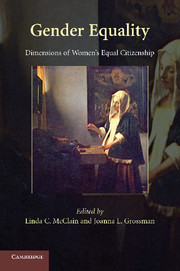Book contents
- Frontmatter
- Contents
- Contributors
- Acknowledgments
- Gender Equality
- Introduction
- PART I CONSTITUTIONAL CITIZENSHIP AND GENDER
- PART II POLITICAL CITIZENSHIP AND GENDER
- PART III SOCIAL CITIZENSHIP AND GENDER
- 10 Pregnancy and Social Citizenship
- 11 Equality: Still Illusive After All These Years
- 12 Razing the Citizen: Economic Inequality, Gender, and Marriage Tax Reform
- PART IV SEXUAL AND REPRODUCTIVE CITIZENSHIP
- PART V GLOBAL CITIZENSHIP AND GENDER
- Suggested Readings
- Index
- References
10 - Pregnancy and Social Citizenship
Published online by Cambridge University Press: 05 August 2012
- Frontmatter
- Contents
- Contributors
- Acknowledgments
- Gender Equality
- Introduction
- PART I CONSTITUTIONAL CITIZENSHIP AND GENDER
- PART II POLITICAL CITIZENSHIP AND GENDER
- PART III SOCIAL CITIZENSHIP AND GENDER
- 10 Pregnancy and Social Citizenship
- 11 Equality: Still Illusive After All These Years
- 12 Razing the Citizen: Economic Inequality, Gender, and Marriage Tax Reform
- PART IV SEXUAL AND REPRODUCTIVE CITIZENSHIP
- PART V GLOBAL CITIZENSHIP AND GENDER
- Suggested Readings
- Index
- References
Summary
Pregnant workers and workers who are new mothers are, fundamentally, workers. They should not be relegated to second class citizenship in employee rights or benefits.
The Pregnancy Discrimination Act does not…require employers to offer maternity leave or take other steps to make it easier for pregnant women to work.
Introduction
Can pregnant working women capture the benefits of equal citizenship? Or do the physical effects of pregnancy, combined with the law's general failure to insist that they be accommodated, make that an elusive goal? This chapter takes up those questions by reconsidering pregnancy discrimination law through the lens of social citizenship.
Despite vital legislative and judicial victories that together had established a broad-based federal right of sex equality by the early 1970s, pregnant women continued to face myriad forms of discrimination in the workplace. During the campaign for and debate over the Pregnancy Discrimination Act (PDA) of 1978, advocates and legislators bandied about the familiar fear of second-class citizenship to argue for greater protection for pregnant women in the workplace. Like other important legislative enactments and of the same era, the central goal of the PDA was to promote women's equality by breaking down formal barriers to participation. At its core, this movement was a quest for equal social citizenship – access to paid work and economic security – for women.
- Type
- Chapter
- Information
- Gender EqualityDimensions of Women's Equal Citizenship, pp. 233 - 250Publisher: Cambridge University PressPrint publication year: 2009
References
- 1
- Cited by



